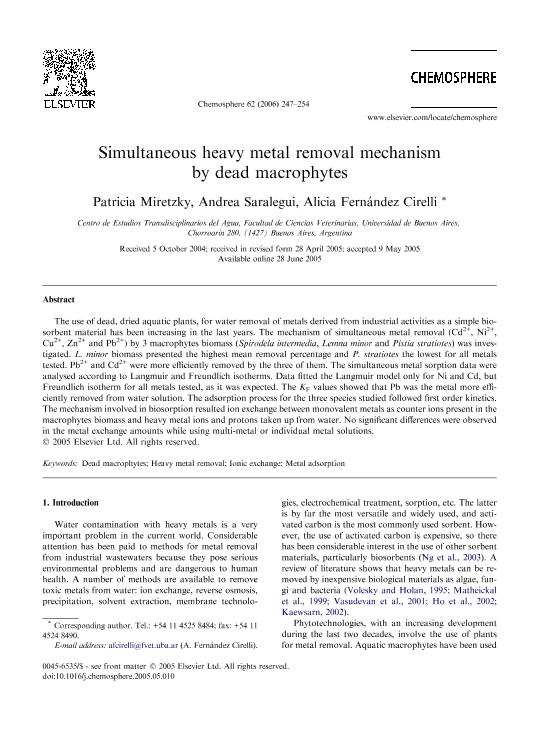Mostrar el registro sencillo del ítem
dc.contributor.author
Miretzky, Patricia
dc.contributor.author
Saralegui, Andrea Beatriz

dc.contributor.author
Fernandez Cirelli, Alicia

dc.date.available
2021-05-20T15:27:18Z
dc.date.issued
2006-01
dc.identifier.citation
Miretzky, Patricia; Saralegui, Andrea Beatriz; Fernandez Cirelli, Alicia; Simultaneous heavy metal removal mechanism by dead macrophytes; Pergamon-Elsevier Science Ltd; Chemosphere; 62; 2; 1-2006; 247-254
dc.identifier.issn
0045-6535
dc.identifier.uri
http://hdl.handle.net/11336/132364
dc.description.abstract
The use of dead, dried aquatic plants, for water removal of metals derived from industrial activities as a simple biosorbent material has been increasing in the last years. The mechanism of simultaneous metal removal (Cd2+, Ni2+, Cu2+, Zn2+ and Pb2+) by 3 macrophytes biomass (Spirodela intermedia, Lemna minor and Pistia stratiotes) was investigated. L. minor biomass presented the highest mean removal percentage and P. stratiotes the lowest for all metals tested. Pb2+ and Cd2+ were more efficiently removed by the three of them. The simultaneous metal sorption data were analysed according to Langmuir and Freundlich isotherms. Data fitted the Langmuir model only for Ni and Cd, but Freundlich isotherm for all metals tested, as it was expected. The KF values showed that Pb was the metal more efficiently removed from water solution. The adsorption process for the three species studied followed first order kinetics. The mechanism involved in biosorption resulted ion exchange between monovalent metals as counter ions present in the macrophytes biomass and heavy metal ions and protons taken up from water. No significant differences were observed in the metal exchange amounts while using multi-metal or individual metal solutions.
dc.format
application/pdf
dc.language.iso
eng
dc.publisher
Pergamon-Elsevier Science Ltd

dc.rights
info:eu-repo/semantics/openAccess
dc.rights.uri
https://creativecommons.org/licenses/by-nc-sa/2.5/ar/
dc.subject
DEAD MACROPHYTES
dc.subject
HEAVY METAL REMOVAL
dc.subject
IONIC EXCHANGE
dc.subject
METAL ADSORPTION
dc.subject.classification
Otras Ciencias Químicas

dc.subject.classification
Ciencias Químicas

dc.subject.classification
CIENCIAS NATURALES Y EXACTAS

dc.title
Simultaneous heavy metal removal mechanism by dead macrophytes
dc.type
info:eu-repo/semantics/article
dc.type
info:ar-repo/semantics/artículo
dc.type
info:eu-repo/semantics/publishedVersion
dc.date.updated
2021-04-28T21:44:08Z
dc.journal.volume
62
dc.journal.number
2
dc.journal.pagination
247-254
dc.journal.pais
Reino Unido

dc.description.fil
Fil: Miretzky, Patricia. Universidad de Buenos Aires. Facultad de Ciencias Veterinarias. Centro de Estudios Transdisciplinarios del Agua; Argentina
dc.description.fil
Fil: Saralegui, Andrea Beatriz. Universidad de Buenos Aires. Facultad de Ciencias Veterinarias. Centro de Estudios Transdisciplinarios del Agua; Argentina
dc.description.fil
Fil: Fernandez Cirelli, Alicia. Universidad de Buenos Aires. Facultad de Ciencias Veterinarias. Centro de Estudios Transdisciplinarios del Agua; Argentina. Consejo Nacional de Investigaciones Científicas y Técnicas; Argentina
dc.journal.title
Chemosphere

dc.relation.alternativeid
info:eu-repo/semantics/altIdentifier/url/https://www.sciencedirect.com/science/article/abs/pii/S0045653505007204
dc.relation.alternativeid
info:eu-repo/semantics/altIdentifier/doi/https://doi.org/10.1016/j.chemosphere.2005.05.010
Archivos asociados
